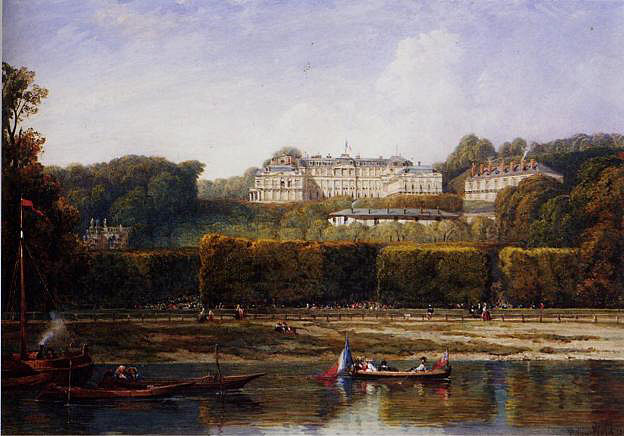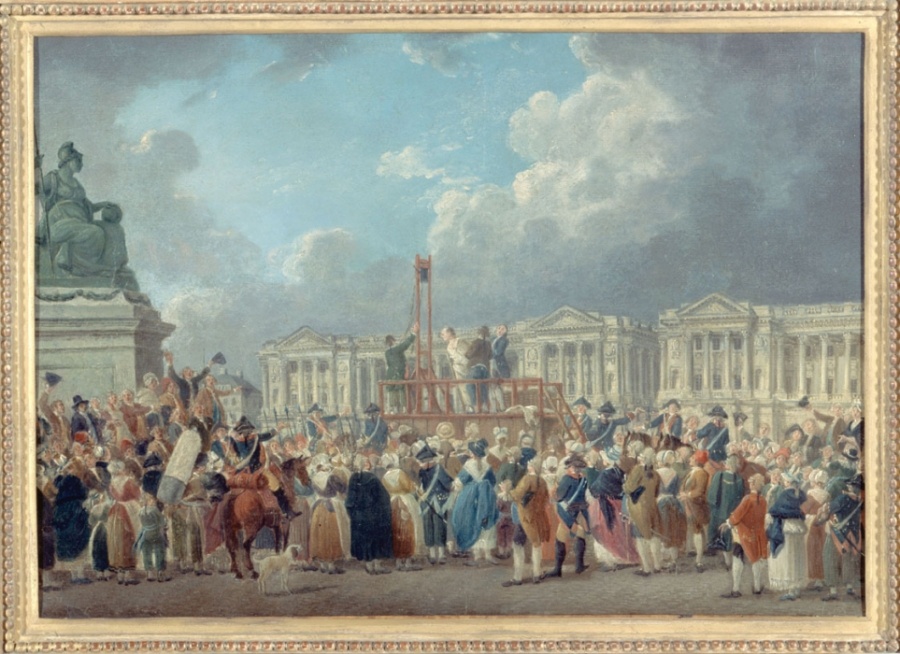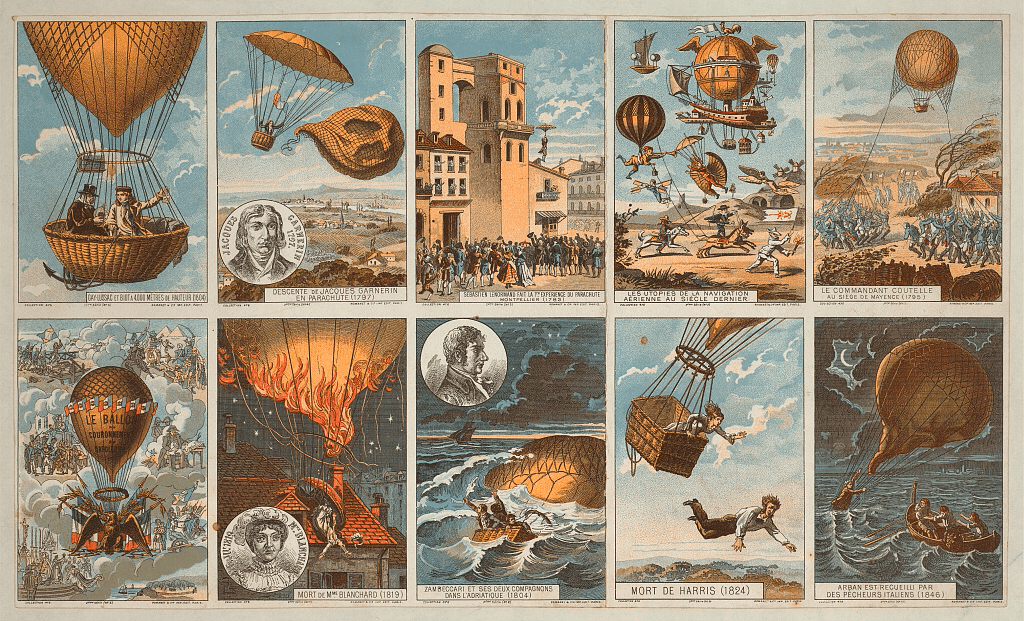In 1781, a young lady visited the palace of Versailles and saw Queen Marie-Antoinette for the first time:
I went to see the ball given by the Gardes du Corps in the Grande Salle de Spectacle, in the Chateau of Versailles. The Queen opened the ball with a simple young guard. She was dressed in a blue gown all sprinkled with sapphires and diamonds; beautiful, young, adored by all, having just given a Dauphin to France, not dreaming of the possibility of a backward step in her brilliant career, she was already on the edge of the abyss.
Journal d’une femme de 50 ans, Henriette-Lucy, Marquise de La Tour-du-Pin-Gouvernet
{Related post: The life of Marie-Antoinette – Queen}
It would be a mere 12 years later that Marie-Antoinette would end her days in prison, and from there to the guillotine. Why was she so unpopular with the people of France?
That Austrian bitch

It didn’t take long for the people of France to shun Marie-Antoinette. She was no worse than any other French royal, but being an outsider, she was an easy target. Despite having a rich lineage of French royal blood through her father Emperor Francis I (he was a Duke of Lorraine and his mother was a grandaughter of Louis XIII), she was still Austrian, a former enemy, and many in France were suspicious of the new political alliance between France and Austria. They felt their suspicions to be well-founded at any attempt by Marie-Antoinette to ‘interfere’ in politics; not only was she a woman, but she was the Autrichienne (a play on words: the French translation for a woman from Austria is Autrichienne, and chienne is a bitch, a female dog).
When will you give us an heir to the throne?
It didn’t help that it was a long seven years before Marie-Antoinette and Louis XVI finally got around to consummating their marriage. For the queen, especially one who loved children so much she had informally adopted a young boy who had almost been run over by her carriage, it was not just the lack of intimacy between a husband and wife; it was her ‘inability’ to produce an heir to the throne which was the most humiliating.
‘However brilliant the Queen’s position at the moment…[she needs] the quality of a mother to be regarded as French…[by this] petulant and frivolous nation’
Comte de Mercy-Argenteau, ambassador, to Maria Theresa, mother of Marie-Antoinette, 1775
In 1775, it was looking likely to all the eager eyes in France that the marriage of the king and queen might remain childless. That same year the youngest brother of Louis XVI, Comte d’Artois (the future Charles X) had his first son. Immediately following the birth, after tenderly embracing the new mother, Marie-Antoinette had to run the gauntlet of the squawking market-women, who, exercising their traditional right to hang around Versailles on
an occasion of importance, pursued the queen by shouting: ‘When will you give us an heir to the throne?’ According to Madame Campan, once in the safety of her rooms, she burst into tears.
One of the problems with being a celebrity royal was, and still is, a complete lack of privacy. One’s intimate moments, weaknesses, foibles, become gossip and fodder for an insatiable public. So too it was for Marie-Antoinette; but in the absence of tabloid journalism and Twitter, satirical pamphlets known as libelles were the means of spreading hearsay, half-truths and complete fabrications. In the beginning, it was all about her seemingly loveless marriage.
In the pamphlet entitled Les Nouvelles de la Cour (News from the Court) printed in 1775, it was asked repeatedly “Can the King do it? Can’t the King do it?” It accused the queen’s closest friend, the Princess Lamballe, of using her ‘little fingers’ to satisfy the queen, and her own mother Maria Theresa supposedly called for Marie-Antoinette to take a lover:
My daughter, to have a successor
It little matters whether the maker
Is in front of the throne or behind it.
How did everyone know what went on (or didn’t) behind closed doors? Sexual relations between royals was a perfectly acceptable topic for dinner table discussion. Their beds were checked every morning for blood or royal ’emissions’. Every month a report went back to Marie-Antoinette’s mother as to whether or not she had had her period (or as she called it, her ‘indisposition’). Things got so bad that Marie-Antoinette’s brother, the Emperor Joseph II, was sent to France to talk seriously to the couple about their little problem.
Finally, the deed was done and the queen fell pregnant, which caused rejoicing across the nation and alleviated her unpopularity to some extent. But the pamphleteers, or libellistes, did not give up, even when her second child was the long-awaited Dauphin. Pamphlets asked whether the king was actually the father; was it his handsome and lively brother, the comte d’Artois, or even the Duc de Coigny, a favourite of the queen. One publication was fairly blunt:
‘Who the Devil produced him?’

This malicious engraving (above) published soon after the birth depicted Marie Antoinette cradling the new baby, with Louis XVI wearing a cuckold’s horns, and an angel with a trumpet who announced to all:
Go, fly, announce everywhere that a Dauphin has been born in France.
But be careful not to open your eyes to the secret of his birth.’
Images of the French Revolution, Stanford University Library
Accusations of sexual promiscuity haunted Marie-Antoinette for much of her reign as consort. In a publication called Le Lever d’Aurore the author took an innocent outing of Marie-Antoinette to watch the sun rise and turned it into a wanton orgy. Despite the dawn visit having been conducted with all propriety and with many attendants, the pamphlet claimed the queen had subtly disappeared into the bushes for a number of amorous rendezvous.
According to these scurrilous writings, the unpopular queen was entirely non-discriminate when it came to choosing her sexual partners. Among the lucky winners were both her brothers-in-law, the marquis de Lafayette, her closest friend the Princess Lamballe and other ladies-in-waiting, guards, grooms, gardeners and anyone else who took her fancy. She was the subject of pornographic cartoons, pamphlets, engravings, songs and plays. Her depravities knew no bounds; she freely committed adultery, pedaphilia, acts of lesbianism, and incest. One wonders where she found the time.
A libelle from 1789 titled L’Autrichienne en Goguettes ou l’Orgie Royale (The Austrian Bitch and her Friends in the Royal Orgy’) has Marie-Antoinette and the comte d’Artois in compromising positions and suggests he was both her lover and the father of her children. Another popular and graphic publication was ‘Le Godmiché Royal (The Royal Dildo) in which the queen is sexually frustrated and uses a multitude of sex toys.
The use of pornography and sexual promiscuity to discredit a woman was not new – it had been used against Catherine Medici 200 years before. And unfortunately it continues today. When a woman is reduced to a sexual being, a depraved one at that, her inclusion in the political world is ridiculed and any attempt to participate in the male-dominated public sphere becomes impossible.
But why was she so unpopular?
Marie-Antoinette was no different to any other French royal who gave nary a thought to their expenditure. The comte d’Artois was a notorious spendthrift and frequently racked up enormous debts. There were the royal aunts, the unmarried sisters of Louis XV who maintained their own separate households at great expense. Even the sisters-in-law of Marie-Antoinette learned the meaning of extravagance on their arrival at Versailles.
For the new queen, there were new dresses every week made of fine silks and lace, elegant slippers worn once and discarded, sparkling jewellery to adorn her slim neck and wrists. Brand new ribbon was needed every day to tie the royal peignoir, as well as fans and gloves for visits to salons and theatres. Card game parties were rife, and thousands of livres were won and lost as they continued into the wee hours. Marie-Antoinette was something of a night owl and would often begin her night’s activities at the time her husband was preparing to go to bed. Her mother implored her:
You lead a dissipated life…I hope I shall not live to see the disaster that is likely to ensue.
Maria Theresa to Marie-Antoinette, 1775

When life at Versailles proved too stultifying, she found comfort in her newly built Queen’s Hameau, a working model farm, or in the theatre she had built next to her much loved Petit Trianon. Here she loved to don theatrical costumes and play the coquette, the ingénue, or in her last treading of the boards she played the girl Rosina in the controversial play Marriage of Figaro.
It is highly probable her excessive spending and her obsession with gambling were in some ways a form of compensation for her loveless marriage and the unrelenting pressure to produce the expected dauphin. She was also young – we have to remember she was married at 14 and became queen when she was only 18 years old.
Regardless of the justification, rumours of gluttonous feasting and sexual depravity against the background of a Petit Trianon paved with diamonds and glittering with gold, became symbolic of resentment with the governing power as a whole – but focused on the Queen.
The château of saint-cloud
Proving that one can have too many châteaux, it was Marie-Antoinette’s desire to have a house (albeit a grande one) of her own that was a factor in her undoing.
She wanted to buy the château of Saint-Cloud, now in the suburbs of Paris, from the duc d’Orléans. The queen wanted a palace of her own, in her own name, and the lordship of the manor as well so she could be something in her own right, not just the consort of the king and mother of the dauphin.
Fraser, Antonia, Marie Antoinette: The Journey, Weidenfeld and Nicolson, 2002

Reminiscing of her own carefree childhood, her official position was that the château of La Muette, where they journeyed for the summer, was too small for her growing brood of three children, and the air one breathed in Saint Cloud was infinitely better.
‘An interesting acquisition for my children and for me … The Duc d’Orléans is selling me Saint Cloud.’
Marie Antoinette to the Emperor Joseph II,
But there was no tradition of French Queen Consorts {Related post: Why are there no French Queens?} being given gifts of a château as their own personal property, with all rights which belonged to it. What would the people of Paris think when they heard “By the Order of the Queen”, an unpopular one at that. Rumours abounded that should the queen die at the château of Saint Cloud, the property would pass directly to her brother, the Emperor Joseph II. But to the French patriarchy it was Marie-Antoinette’s audacity at sitting in on meetings with the king in the purchase of the château which was the most appalling.
However, with the support of the king, the château was bought, and decorated with exquisite (and expensive) taste as befits a queen. The château is now long gone, destroyed in the Franco-Prussian war of 1870.
The queen’s necklace affair
By far the most damning event in the life of Marie-Antoinette, and goes a great deal towards explaining why she was so deeply unpopular by the time of the French Revolution, is the Diamond Necklace Affair.

It was the brainchild of Jeanne de Valois, descendant of an illegitimate son of Henri II, of the Valois dynasty. Despite her heritage, she grew up an orphan, begging on the streets, until she was taken in by a patron of the French court. She conspired with several others to obtain a cascading diamond necklace made at least ten years previously by Charles Auguste Boehmer, a well known Swiss jeweller. Boehmer had tried to sell the necklace, which cost 1.5 million francs ($4.7 million today), several times to Marie-Antoinette but she had always baulked at the high price, and ironically, as she grew older she was becoming a little less frivolous.
The dupe in all this scheming was the Cardinal of Rohan. The Rohan family, despite being fairly powerful were somewhat on the periphery at the time, subject to Marie-Antoinette’s long standing animosity. Cardinal Rohan was determined to restore the family to favour within the royal court. Jeanne de Valois happened upon Rohan and the scheme came to fruition. She gave him forged letters which were supposedly from the queen herself, signed “Marie-Antoinette de France”, asking him to negotiate with Boehmer the jeweller to buy the fabled necklace. Whether he was gullible or guilty, Rohan did what he was asked, and the valuable necklace was soon in the hands of Jeanne and her accomplices, hacked into pieces with a kitchen knife and sold in London.
So imagine the surprise of the queen when she received a polite yet mysterious letter in July 1785 from Boehmer, thanking her for the honour of the purchase but seeking payment. Investigation at the highest levels followed, and both Rohan and Jeanne were arrested. Rohan was spirited off to the Bastille where, as befits a Cardinal, he supped and slept in quite luxurious prison rooms. A very public trial followed. With much political maneuvering on the part of those who loathed Marie-Antoinette and her meddling in royal affairs, Rohan was acquitted. His fate was to be exiled to an obscure part of the Auvergne, an abbey in the mountain-top village of Chaise-Dieu.

Jeanne de Valois was sentenced to life imprisonment and a public flogging. She was stripped naked and tied by a rope, and branded V for voleuse (thief). Under mysterious circumstances she was able to escape two years later and settled in London.
The worst of the so-called l’affaire du collier de la reine (the Queen’s necklace affair) was that everyone believed Marie-Antoinette to be guilty. The public truly believed the stories told by Jeanne: that the queen had met Rohan in a park in the middle of the night and given him a rose in order to seduce him; that there were over 200 letters between the two in which the queen used the informal ‘tu’ reserved for lovers and close friends; that she was capable of deceiving him in order to take a necklace and pay nothing. Even the Parlement themselves, on reflection, noted that the queen had swathed herself in diamonds in 1774–6, and had shockingly appeared on the terrace at night in mixed company in 1778 (in fact, she had been pregnant and took evening walks to cool herself).
It was noted by a friend that the reception she received when undertaking the traditional visit to Paris after the birth of Louis Charles in 1785 was cold and silent.
What have I done to them then?
Marie-Antoinette to Madame Campan
It seemed there was nothing the unpopular and hated Marie-Antoinette could say or do to please the royal courtiers, the politicians, or the people of France. Was she a scapegoat for a France in desperate need of reform, or merely a victim of circumstance? In 1789, the resentment would become an uncontrollable wave of anger, washing away the only world she ever knew.

Stay tuned for Part 4 – The death of Marie Antoinette
Further reading
The Petit Trianon so beloved by Marie Antoinette was actually built for Madame de Pompadour, mistress of Louis XV, so they could indulge themselves away from the eyes of Versailles. This exhibit explores the history of the lovely château and how Marie Antoinette made it her own.






